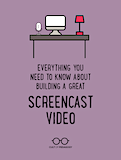Digital Teaching Gains: What Will We Keep?
A MiddleWeb Blog
We asked teacher educator and former Kansas TOY Curtis Chandler to write about Covid-19’s carryover lessons. Last week, he focused on the prime directive: “Teach what matters most.”
In Part 2, Curtis (a former tech integration coach) talks about the pandemic’s silver lining: a speed-up in the adoption of digital tools that promote student engagement and collaboration. So what do we do now? What tech do we keep and what do we put away?
Before the pandemic, the vast majority of classroom educators in the USA seemed to be at opposite ends of an instructional technology continuum.
On one side there were technophiles. These teachers loved and embraced technology—often to a fault. Their classrooms and lessons were inundated with multimedia and a virtual chest of shiny, digital tools that would rapidly fall out of favor…often before students even had a chance to master them.
In the technophile’s classroom, students felt as though the ground was continually shifting beneath them. It was not uncommon for them to spend as much time trying to figure out how to use the technophile’s new, chic tool/app as they did on the actual assignment. Such learning environments might have felt ‘in the know,’ but resulted in little-to-no evidence of impact on student success…particularly those kids who needed help the most (Wexler, 2019).
On the other end of the spectrum were teachers who were technophobes. These educators’ negative feelings and attitudes towards tech caused them to avoid (and even resist) the use of instructional technology (Bardakci & Ünver, 2020).
As a result, the technophobes forfeited valuable opportunities to streamline instruction and engage learners’ senses with a blend of print and digital resources. Their students, in turn, often missed out on chances to collaborate using a medium they love and connect with other’s ideas and perspectives.
A Practical Approach to Instructional Technology
One of the unexpected benefits of teaching during the pandemic was that it largely depolarized the use of instructional technology.
Technophobes were forced to step it up and develop new digital skill sets while technophiles learned quickly that they needed to be more deliberate, purposeful, and consistent in how they delivered instruction and supported students in learning.
Being catapulted into remote teaching/learning was frustrating and demoralizing for educators and their students. It was future shock at its most raw and unforeseen. However, some unexpected payoffs have emerged in the months since March 2020, included the following (Bushweller, 2020):
► Improved teacher attitudes towards and skills in instructional technology
► Educators with higher levels of experience troubleshooting technology
► A marked increase in school-provided personal devices
► Teacher movement towards a wider array of instructional methods
In other words, teacher technology use wasn’t the only thing to improve during the pandemic. Many educators also used the shift to distance and hybrid learning as an opportunity to develop a more robust and supportive teaching approach with their students.
The Lessons I Think are Keepers
Among the many emergency teaching tactics and strategies that surfaced during the pandemic, a handful of keepers should propel us into the start of the coming school year.

► All students, particularly those who often need a bit more support, benefit greatly from increased teacher clarity. This starts with taking the time to develop and communicate a clear direction and purpose for each lesson and learning activity. It also means making clear your grading criteria, and when possible, providing exemplars of what different levels of performance and success on a task look like.
► Every lesson and assignment that we design should be as straight-forward and accessible from home as it is face to face in a classroom. Instead of barraging students with a cluster of new tools to learn every week, consider utilizing a single, robust platform or format consistently throughout the year, whether it’s Google Classroom, Blendspace, Eduflow or something similar your district expects you to use. Doing so minimizes the time required to learn and troubleshoot new tech.
► Class time is extremely valuable, so embrace pre- and post-recorded videos as key elements of instruction. It takes students multiple exposures to master new content and skills. So why not take much of that necessary but clock-eating teacher talk time and turn your teacher-centered instruction into interactive videos that students can access whenever they need the information (thereby making it more student-driven!).
Whether it’s an overview of a new concept, a tutorial on how to complete an assignment, or a brief review of something from class, teachers can and should use screencasting and other simple video tools to free up in-school time for students to connect, collaborate, and think critically about what is being taught.
Over the summer (particularly this one) we don’t need to create every video that we might need throughout the school year. What’s more important is to stay about two weeks ahead and be familiar enough with the tools needed to create and post them for your students to minimize production time.

►Check in with students regularly about how to better support their learning. Use tools like Google Forms, YoTeach, Poll Everywhere, or AnswerGarden to get specifics on what is going well, and what needs to be improved.
Continuing Forward
I can’t help but be impressed by the changes made by so many fellow educators during the long pandemic months. In Part 1 of this reflection, I told the story about my quarantined friend who found the motivation to improve his diet, his exercise regime, and his physical health during his pandemic isolation.
Impressive. But even more remarkable is the degree to which educators around the country have used the considerable challenges of teaching remotely to streamline instruction and more deliberately support students.
Our biggest challenge is still before us, though. As education moves back to a more “normal” classroom setting, each of us must continue to apply what we have learned during this time of unprecedented struggle to keep our learning and our students’ learning moving forward.
If we give into an understandable urge to return to our traditional comfort levels – if we revert to old, ineffective approaches – we will miss out on what could be a once-in-a-lifetime opportunity to change the way we do school for the better.
References
Bardakci, S., & Ünver, T. K. (2020). Teachers and interactive white boards: A qualitative investigation in the margin of technophobia. Australian Educational Computing, 35(1).
Bushweller, K. (2020). How COVID-19 is shaping tech use. What that means when schools reopen. Education Week. https://www. edweek. org/ew/articles/2020/06/03/howcovid-19-is-shaping-tech-usewhat. html.
Wexler, N. (2019). How classroom technology is holding students back. MIT Technology Review. Retrieved January, 23, 2020.



































